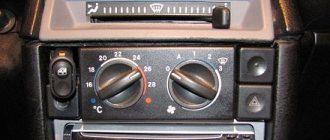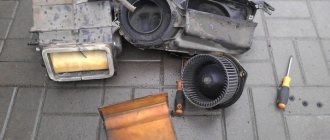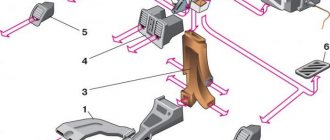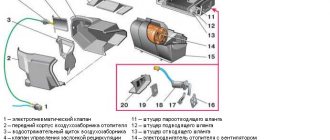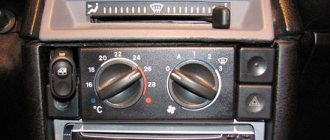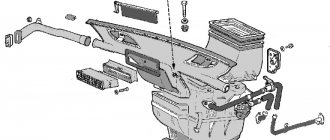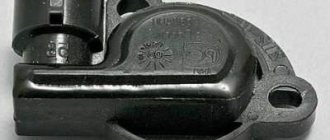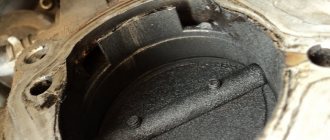In general, the problem is that the stove does not blow very warmly, the gear motor is broken (does not make sounds), I think it did not press the damper tightly, which is why the stove does not heat
IS IT POSSIBLE to somehow close the heat/cold damper manually?
2110, 2006, euro panel. I'll delete the topic myself.
Comments 25
You unscrew the wipers, unscrew the frill, on the left side of the car you put your hand to the stove and feel... I have a 2002 unit, I could barely get there to unscrew it, but it still worked... The fact is that the heater damper gear motor is not the same type, they are of different years and types, so it’s better to remove them, go to the spare parts store and ask for the same one... Mine cost 1800 rubles in the summer, and was not of the best quality (plastic), so I went through the mechanism of the old one, screwed it up well, pressed the case and put it back... It works ))) By the way, I have a topic about the stove and a hand-made homemade test controller (ala everything directly).
On the VAZ 10th family, which includes the VAZ 2110-2112 models, the designers used an electronically controlled interior heating system, thanks to which the temperature set by the driver is maintained automatically.
On the VAZ-2110, instead of a manual heater control mechanism with a cable drive of the main elements - the coolant shut-off valve and dampers, an automatic heater control system (AHC) controller with a temperature sensor and a gearmotor that regulates the position of the dampers are used.
In such a stove, the valve for shutting off the antifreeze supply is no longer used, and the adjustment of the heater operating mode - “heating” or “ventilation” - is carried out by a central damper, which directs the air flow through the radiator or bypassing it.
How malfunctions manifest themselves
The automatic temperature maintenance system used on the VAZ-2110 is more convenient in terms of control, since the automatic control system does everything independently, but is less reliable than a mechanical cable drive. Moreover, problems are caused by the electronic and electrical components of the stove - the controller, temperature sensor and micromotor gearbox, the central damper, which regulates the air supply to the cabin from the outside.
Problems with the operation of the VAZ-2110 heater related to the damper:
- lack of temperature control (only hot or cold air comes from the stove) regardless of the position of the handle on the controller;
- insufficient air heating (even when setting the handle to the maximum temperature);
- squeaks, knocks and extraneous noises after setting the temperature.
The cause of such problems is the central damper of the VAZ-2110 stove, which is adjusted by the controller through a gearbox. The design of the stove includes another damper - air distribution into zones. It is controlled using a handle mounted on the central air supply deflector into the cabin, so malfunctions with this part are rare.
Principles of interior ventilation
Before you understand the causes of the malfunction, you should know the principle of the device and the rules by which ventilation is carried out. So:
- Air is supplied to the passenger compartment through the holes in the trim on the windshield : when the car is moving voluntarily, or forcibly with the help of a heater fan.
- Air escapes through the gaps between the inner door panels and between the upholstery, then through the holes located at the ends of the doors. The thermal insulation of the interior is improved by valves built into the openings, which allow air to pass out and prevent it from entering the inside of the car.
- The main part of the air is directed to the windshield; flows are directed to the central part and side windows through deflectors blocked by flaps.
- Air is supplied to the driver’s feet and the passenger sitting next to him through two pairs of deflectors: one pair is located near the floor, the other at knee level.
- Through a lining located on the floor tunnel and two air ducts built under the front seats, air is supplied to the feet of passengers in the rear.
- To prevent the entry of outside air, especially if the road section is polluted, smoky or very dusty, there is an air recirculation system. When the recirculation button is recessed on the instrument panel, the electro-pneumatic valve opens. In this case, under the influence of the vacuum that occurs in the intake pipe, the access of outside air is blocked by the recirculation system flap into the vehicle interior.
- The air temperature is regulated by the controller handle from 16°C to 30°C.
- Information about the temperature is read from its sensor by a unit with a microfan located on the ceiling. The unit turns on the micromotor when a temperature difference occurs, which controls the heater dampers. When the damper reaches the desired position, a signal is sent from the sensor to the control unit, which turns off the micromotor.
Features of the design of the VAZ - 2110 stove damper
Note that VAZ-2110 of different years of manufacture uses heaters that differ in design:
1. Old-style stove damper
Old heaters use two central dampers, one of which blocks the flow of air into the cabin from the outside, and the second one redirects the air flow to the heater radiator or bypasses it. They are interconnected by drives and opened by a micromotor gearbox.
2. New sample
In the new type of stove there is only one central damper and it is connected by a drive to the gear motor directly, and not through a lever.
3. Under the “Euro” panel
Structurally, such a stove does not differ from the new type of heater, but in it the damper for distributing the air flow into zones is controlled by another micromotor gearbox.
It is easy to visually distinguish the stoves by the location of the heater fan. In the old-style interior heater, the fan is located horizontally, while in the new model, it is positioned vertically. Their gearmotors are also different.
Adjusting the heater dampers
By adjusting the dampers with your own hands, you eliminate the supply of part of the air “to the glass” when the lever that controls the air flow is installed in the heater in the “chest” or “legs” position. The photo shows the damper adjustment control units.
Adjustment unit with control lever positioned vertically
2 – adjustable rod for installing the damper “in the chest” – “in the legs” 3 – fastening the rod “in the chest” – “on the glass”. To do this, you need to shorten the adjustable rod by three divisions, and use side cutters to bite off the protruding tip on it. After performing such operations, the heater damper will be in the desired position, and the heat from the stove will flow better in the given direction.
Causes of malfunctions
Depending on the design of the stove, the damper may cause a disruption in the efficient operation of the heater for the following reasons:
- deformation;
- wear of seals;
- deterioration or damage to control levers and rods;
- skew.
Deformation is a problem with old-style heaters. The first dampers of the VAZ-2110 stove were equipped with plastic elements that bent under the influence of temperature. Because of this, even when completely closed, cold air from outside leaks in and mixes with the heated air, and the efficiency of the stove decreases. Subsequently, the designers replaced the plastic flaps with aluminum ones and the problem with deformation disappeared.
To ensure tightness, the dampers have seals that reduce air leakage. Initially, foam rubber seals were used, which quickly wore out and became damaged. Later, foam rubber was replaced with rubber, but this only extended the service life of the seal; over time, the rubber ages, cracks and collapses.
On old-style stoves, rods and levers may break. On new heaters, there is another problem - wear on the edges of the square end of the gearbox, with which it is inserted into the groove made in the damper axis. As a result, the limit switch bypasses the groove, and the heater damper jams, although the gearmotor operates. The misalignment occurs due to the displacement of the damper axis in the mounting holes of the housing. Because of this, the damper warps and jams when opening.
VAZ 2110 heater blows cold, reasons
Many owners of “ten” complain that at some point the stove constantly blows cold air and no amount of turning the handles of the automatic heater control system can save the situation. There can be a lot of problems and malfunctions. For example, the ACS controller itself is faulty, the ceiling sensor or micro-geared motor is faulty and simply does not open or close the damper. Another reason is the air (air lock) in the heater radiator, which is simply not capable of heating the air passing through it.
Heater dampers VAZ 2110
Often the cause of poor performance of the “ten” heater is the damper of the VAZ 2110 stove. The damper may not close tightly or open poorly. The heater flap itself is made of plastic, which can become warped and perform poorly over time. Many car owners buy a metal damper and change it themselves. How to check the functionality and evaluate the condition of the heater damper? Everything is quite simple, remove the central air duct deflector and there you have it - a damper!
Next, carefully inspect the damper, turn on the stove, turn the controls on the ACS unit and see if the damper works at all. How does it move, does it fit tightly. If she does not respond to commands, then the problem may not be her at all. For one thing, you can see if the lever for redirecting the air flow from the glass to the feet works.
Diagnosis of the problem
If the reason why the VAZ-2110 stove does not work is the damper, it is not difficult to identify it. To do this, disassemble the central deflector, turn on the ignition and rotate the temperature setting knob to its extreme positions. In a working stove, the central damper will not knock and will completely open and close the air supply channel.
If the heater damper does not move or stops in a position that does not completely block the air passage, it may be stuck. You can verify this by pushing the valve with your hand or a long rod. If after this the damper returns to its normal position, then this is the reason why it is jammed. Through the mounting hole of the deflector, you can assess the condition of the damper and its seals. If the damper is deformed, its bend is clearly visible.
Assembly of the unit
Interchangeability of gearmotors
When work on restoring the functionality of the MMR is completed, install it in place. For this:
- Insert the pin of the micromotor-reducer lever into the slot of the lever. It is located on the damper drive;
- If the lever is not turned properly, apply 12V voltage to the motor connector pins using two wires. We are talking about yellow wires here. This way you can return the lever to the correct position;
- Having installed the micromotor-reducer, check it for operability, plus watch how the damper drive of your heater moves, whether the heater control lever “plows” properly to regulate the temperature.
We will repair or replace the damper and heater drive, you will be able to return the heater to its previous functionality and independently determine what temperature regime will be set inside the cabin of your VAZ 2110.
Repair and restoration of the stove damper
The deformed heater damper of the VAZ-2110 cannot be repaired; it only needs to be replaced. In this case, it is better to purchase a replacement metal part that is not so susceptible to temperature effects.
Whatever heater is installed on the VAZ-2110, to carry out repair work, the heater must be completely disassembled. In this case, the process of dismantling and disassembling depends on the design of the stove.
A positive aspect of the heater design on the VAZ - 2101 is its location - to get to it and the dampers you can from the engine compartment and you don’t have to remove the front panel.
Disassembling an old-style stove
For example, let's look at how to disassemble an old-style heater:
- Remove the terminal from the battery.
- We remove the windshield wipers, the seal, remove the air intake near the windshield (“jabot”) from the car, in the process you will need to disconnect the windshield washer nozzle tubes.
- We dismantle the insulation that separates the stove body from the engine compartment.
- We remove the gear motor.
- We divide the housing of the stove and air filter into two halves. To do this, unscrew the coupling bolts around the perimeter of the housings and remove the mounting brackets.
- Disconnect the fan power wires.
- Remove the outer half of the air filter and heater housing (along with the fan).
- We dismantle the inner part of the fan housing.
After this you will have access to the dampers. If you are only planning to repair or replace the heater dampers, there is no need to drain the antifreeze, since the heater radiator will remain in place and will not be removed.
Before removing the dampers, carefully inspect and remember their position and the way they are engaged. Further actions depend on the nature of the damage. Deformed damper parts cannot be repaired and only need to be replaced. As for damaged rods and levers, try to repair them or simply replace them. The damaged seal is replaced.
Malfunctions in the heating system of the VAZ 2110 and methods for eliminating them
If a control unit, a temperature sensor with a microfan, a micromotor, or a heater damper position sensor fails, it is best to replace it with new ones, otherwise the cost of repairing the vehicle may become significantly higher if it continues to be used with faulty components. If the moving damper makes a characteristic sound that can be heard in the cabin, and the air does not warm up, then the damper or its drive is damaged . In this case, it is necessary to replace the heater damper of the VAZ 2110 or replace the heater damper drive of the VAZ 2110.
How to find out the reasons for the breakdown of the VAZ 2110 heater damper and troubleshoot problems?
The most common problem is when the heater regulator does not perform its functions, that is, it does not respond to the driver’s commands. A hot or cold air flow comes from the air duct, regardless of the position of the regulator.
In this article we will look at how to change the heater damper of a VAZ 2110 , but first we will dwell on the causes of the breakdown.
If the gearbox is in good condition, and the damper does not “respond” to the driver’s manipulations, then characteristic clicks are heard when the regulator is switched. This indicates that the shaft is turning inside the structure. Repair can only be done in one way - replacing the old damper with a new one. It must be emphasized that the old dampers are made of plastic. In turn, the new design is made of metal. For a tight fit to the surface, gaskets made of rubber are used.
Common faults
Most often, the VAZ 2110 suffers in terms of heating because the heater adjustment, as they say, does not work. Regardless of the selected position of the temperature control knob, only cold or, conversely, only hot air blows from the heater.
The reasons for this phenomenon may have different origins. Among them:
- Jamming of the MMR (micromotor-reducer) that controls the damper drive;
- The plastic damper (the first VAZ 2110 was equipped with these) has a destroyed seat, and due to jamming it is impossible to control it normally. If the gearbox is working, but the damper does not turn, you can most often hear peculiar clicks - this is the square shaft turning in the socket. For such a malfunction, there is only one treatment - replacing the old plastic damper with foam insulation with a new one. Better, more modern, metal, with a rubber seal. This one does not warp or warp like its plastic sister;
- To finally decide who to blame - the damper or the MMR, you still need to pay attention to its control unit. He is also among the “suspects”.
First step: check the functionality of the device
Before ordering a new damper from an online store and performing repair work, you need to make sure that such actions are up to date. It is possible that the old-style VAZ 2110 heater damper could become loose, jammed, or jump out of its place. To check you need:
- start the car;
- set the regulator to different positions;
- manually move the flap.
The plastic damper has a huge disadvantage: when high temperatures occur, the plastic becomes deformed. As a result, the valve may jam, and only cold or hot air will enter the cabin.
Old-style dampers are installed on VAZ-2110 cars manufactured before 2003. As a result of manual movement of the valve, the functionality of the stove can be temporarily restored. But such work cannot be called a full-fledged repair, since after some time the problem in question will manifest itself again.
It is important to pay attention to in what case the valve can be controlled. The breakdown may be hidden in the micromotor-gearbox if the valve is controlled with the engine running and the regulator in the extreme position.
Also, do not exclude the control unit and microfan from the list. These elements can also cause the problem in question.
A malfunction of the control unit, fan and gear motor indicates that the stove needs to be replaced. This is the only solution to the problem. If the work is not completed in a timely manner, the motorist needs to prepare for more serious consequences and expensive repairs.
Of course, before opening the damper of the VAZ 2110 stove manually and moving it, you will need to remove the deflector. The air duct deflector is dismantled directly from the seat without the use of additional tools. The work must be done carefully so as not to break the wire contacts.
The device of the VAZ-2109 car heater
As mentioned above, the design of the heating system of the “nine” is quite simple. Let's look at it in a little more detail. In particular, the stove itself consists of 2 casings. They are made of plastic and connected to each other with special brackets. The designers decided to use a harness as a sealant - it is placed in the corresponding grooves of the casings. At the top of the heater there is a fan responsible for the forced supply of heated air into the car interior. It is secured with 2 screws. It should be noted that, if necessary, the fan can be removed or replaced by approaching it from the side of the engine compartment. This solution is quite convenient.
An electric motor is attached to the fan casings. Installing 2 resistor spirals will allow you to choose one of three possible rotation speeds. One point should be noted. An additional resistor is responsible for selecting the desired speed.
It is located on the left side of the stove casing and is secured with 1 screw. Finding it if necessary will not be difficult.
A radiator is installed in the stove casings; here, in fact, the air is heated, which is then supplied to the cabin. It is located on the right side. The radiator is attached to the casing using 3 screws, and the designers chose a polyurethane foam gasket as a seal. The heater consists of:
- cooling plates;
- tubes;
- 2 plastic tanks.
The design of the heater tap is also quite simple. It consists of a body and 2 pairs of pipes. The heater faucet is connected to the cooling system with rubber hoses. As you can see, there is really nothing particularly complicated here. The pump is responsible for circulating fluid in the cooling system. There is a valve located on the supply line in the valve body. It has a hole that allows coolant to pass through. You can control the air heating using the appropriate handle. This is ensured by connecting its lever to the valve through a rod. The operating principle here is as follows. After turning the lever, the hole in the valve opens the line. After this, the liquid begins to flow into the radiator along the path freed from the obstacle.
The stove can be controlled directly by changing the position of the 3 handles. Their levers are mounted on the axles of a plastic bracket, which, in turn, is attached to the dashboard with 4 screws. Let's look at how this system works. The handle responsible for controlling the heating can be used to operate the gran lever. As already mentioned, this is done through traction. This handle also adjusts the position of the damper by acting on its drive lever.
To start the process of supplying warm air to the cabin, you need to do one simple manipulation. Simply move the handle to the far right position. After this, the tap and damper will open completely, and the liquid will rush into the radiator. The fan, in turn, will forcefully supply already heated air into the car interior - however, you will have to wait a little here. Before you feel the heat, the radiator still has to heat the fluid to the desired temperature.
How to remove the stove on a VAZ-2110 car?
Carrying out repair work will require some effort and time. But the most important thing is to adhere to the sequence of actions. To do this you need to do the following:
- drain antifreeze or other coolant;
- disconnect the car. To do this, you need to remove the negative terminal from the battery;
- dismantle the windshield trim and the Shumka;
- remove the fan;
- disconnect the pipe from the stove;
- Remove the front part of the air intake. To complete the work, you will need to dismantle the dashboard. The work must be done carefully and slowly. Fastening elements are unscrewed inside the cabin. They are the ones who hold the stove;
- dismantling the spring brackets and fasteners of the front housing of the heating equipment;
- disconnecting all hoses from the radiator;
- removing the rear casing from the stove;
- dismantling the radiator of heating equipment.
Disassembly
Naturally, replacing a VAZ 21210 damper that works poorly or does not want to change its position at all begins with a rather troublesome analysis. Here are its stages:
- Draining coolant from the heater system;
- Disconnecting the battery. It is enough to disconnect the “minus”;
- Removing the trim, windshield trim, sound insulation upholstery;
- Removing the stove fan;
- Disconnecting the vacuum hose clamp from the heater body;
- Removing the front heater air intake housing. The work is meticulous and not fast. To make disassembly easier, removing the instrument panel can help. From inside, unscrew the screws that secure the heater, then it can be lifted;
- Removing spring brackets, mounting screws and removing the front housing;
- Removing all hoses from the radiator;
- Disconnecting the rear heater casing;
- You need to remove the radiator from the stove;
- It is now possible to replace the damper.
You can read more about replacing the VAZ 2110 heater radiator here:
Installing a new damper on a VAZ 2110
Before installation, you must ensure that the fork is securely coupled to the lever. The valve should be in the raised position. If this is not done, the device will not function. The procedure for installing the device follows the same pattern as disassembling, but in reverse order. At the final stage, coolant must be added to the system. It is recommended to ensure that there are no leaks in the system. Now you can turn on the heating equipment and check its functionality.
It is important to pay attention to the tightness of the connections. Only if the damper is carefully attached to the surface of the heating stove is the flawless functioning of the system guaranteed.
If your car has a standard valve made of plastic, it is recommended to replace it. The disadvantage of old valves is the foam seal, which does not have a long service life. Modern dampers are made of metal, and the rubber seal has fairly high performance characteristics. This design is practically not subject to temperature effects and fits tightly to the surface of the stove. The modernized seal plays an important role in this.
Reassembly
The new damper on the VAZ 2110 must be installed so that the fork on its axis engages with the lever. It is correct if the damper is in the raised state. Otherwise, it will be impossible to control it, and the operation of the stove will not be restored.
Next, we put everything back in place in reverse order. Fill the cooler. We check the functionality of the dampers, the tightness of the hoses and all connections. Then we turn on the stove and monitor the heater. If his work satisfies us, then the repair was successful.
Drive problem
When changing the damper, do not forget to check the functionality of the actuator.
Drive unit
If the micromotor gearbox does not work, it will have to be repaired or simply replaced with a new one.
- Having removed the trim and trim from the windshield, directly behind the vacuum booster of your “ten” you will find a micromotor gearbox. Disconnect two connectors from the amplifier - the micromotor and the micromotor-reducer. Now unscrew the screws and
- remove the micromotor gearbox. You have to remove the motor from it.
- Connect it to the automatic control system to check its functionality.
If the device does not work, you can try to repair it. For this:
- Bend the pressed side slightly and remove the lid;
- Check the condition of the commutator, brushes and bearings;
- Replace the specified components or correct them;
- If the gear teeth are worn out on the gearbox, it will have to be replaced;
- Be sure to lubricate the bearings. Ideally, a silicone-based lubricant should be used;
- If the above measures do not help, simply install a new unit.
Checking the functionality of the manual heater damper of the VAZ 2110
If a car enthusiast simply does not have the funds for professional car repairs, you can try to fix the problem yourself.
But before that, you should check the functionality of all elements of the stove separately. This is the only way to understand what exactly is not working. To do this you need to perform these steps:
- Turn on the ignition;
- After this, check the regulator by switching it in different directions;
Diagnostics
To diagnose, you need to try to manually move the heater damper. This is necessary in order to check whether it is jammed. This will also help return the damper to its original working position. This will solve problems with the damper if it has been misaligned and is simply stuck.- But to gain access to the damper itself, you will need to remove the deflector. If after all these manipulations the damper started working, that was the problem.
- But this was an inferior way to fix the stove. After all, after this, the stove will still not be able to work as before. After all, the nest will already be worn out. If you constantly use this method, the stove may completely break down at any moment. To completely get rid of problems with the damper in the 2110 stove, you need to completely replace it.
- The main thing is not to forget to pay attention to how exactly the damper is controlled. If it is controlled only manually, the problem is in the micromotor gearbox. Also, all problems may be associated with a malfunction of the microfan. Also, the problem may lie in the control unit. That is why you need to check all components of the stove. If any of these devices does not work, you need to urgently replace this part. Due to these violations, the damper of the VAZ 2110 stove will not open. If this defect is not corrected in time, the entire stove may have to be replaced. And this is already several times more expensive than replacing the damper.
The main reasons for the inoperability of the VAZ-2112 stove
Before carrying out repairs, it is extremely important to ensure a successful diagnosis. Here are the reasons for this problem:
- lack of ability to adjust the temperature;
- the stove cannot change the heating speed;
- breakdown of elements that should distribute warm air flows throughout the car interior;
- violations in the temperature sensor installed on the ceiling;
- malfunction of the ACS controller;
- Antifreeze leak.
Carrying out diagnostic measures will allow you to understand what the problem is and how it can be successfully eliminated.


